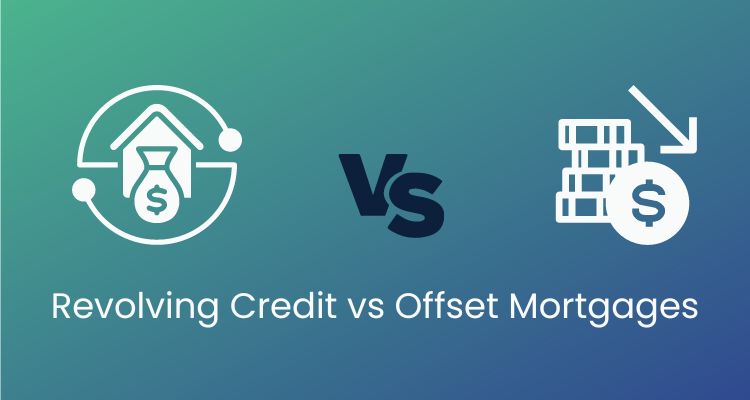When deciding how to best manage your home loan, you might be weighing up the pros and cons of a revolving credit vs offset mortgage. Each one offers unique benefits that could help you save on interest and reduce your loan term, depending on how you handle your finances.
The concept behind both is fairly straightforward: use your own money to offset the amount of interest paid on your home loan.
With revolving credit, it’s like having an overdraft or a line of credit, allowing you the flexibility to draw funds up to your credit limit and make repayments on your own terms. Think of it as a giant credit card secured against your house. The balance reduces the loan amount used to calculate interest.
Revolving credit can be a powerful tool for those who are disciplined with their spending and regular with their repayments. The key here: disciplined.
An offset mortgage provides a more structured approach. Your savings and everyday funds sit in separate accounts linked to your mortgage. The total balance in these accounts is ‘offset’ against your loan amount. When calculating interest, this can lead to substantial savings over the life of the loan.
The appeal here lies in potentially faster loan repayment and the ability to connect various accounts, like those of family members, to maximise interest savings. Offset accounts have less temptation to spend available credit.
With an offset mortgage, every dollar in your linked accounts works harder for you, chipping away at the interest you’d otherwise pay. Let’s explore both these mortgage options further.
Table of Contents
What is a Revolving Credit Mortgage?

Revolving credit is a type of credit that allows you to borrow money up to a certain limit, make repayments, and then borrow again. It’s like having ongoing access to funds up to your credit limit, which you can use as needed.
The official definition of revolving credit from the Reserve Bank of New Zealand is:
Revolving credit loans are loans that have a fixed limit but no scheduled principal repayment. Such loans can be redrawn and paid back repeatedly within approved limits without further credit approval.
RBNZ
How Revolving Credit Works
Imagine you have a pot of money you can dip into at any time; this is how revolving credit works. You’re assigned a credit limit, and you can use portions of this limit to cover expenses as they come up.
As you repay the borrowed money, your available credit grows, ready for you to use again. Managing this continuous access to capital requires careful budgeting to avoid overextending yourself.
Here are the key basics:
- Credit Limit: The maximum amount you can borrow at any time.
- Flexibility: You have control over how much and when you borrow.
- Interest Rate: Typically variable, calculated daily on the outstanding balance.
- Discipline: It’s on you to ensure you don’t spend beyond your means.
Common Features of Revolving Credit Accounts
With revolving credit accounts, your usual features include:
- Accessibility: Withdraw funds up to your credit limit at any time.
- Interest Rates: These accounts typically come with floating interest rates, that change over time.
- Monthly Statements: You’ll receive statements showing your transactions, balance, and interest charged.
- Minimum Payments: Each month, you’ll be required to make a minimum payment to keep the account in good standing.
Revolving credit is a dynamic and useful financial tool. The key to making it work for you is to remain vigilant with your spending and ensure it remains a benefit rather than a burden.
What are Mortgage Offset Accounts?

Offset accounts offer a way to use your savings effectively to reduce the interest you pay on your mortgage. They’re a financially savvy tool that can make your money work harder for you.
Offset Account Basics
An offset account is a savings account that’s linked to your mortgage. The money in this account ‘offsets’ your mortgage balance, meaning you’re only charged interest on the difference. For instance, if you’ve got a mortgage loan of $500,000 and an offset account with $20,000 in it, you’ll only pay interest on $480,000 of your loan.
Benefits of Using an Offset Account
Using an offset account comes with several benefits:
- Save on Interest: By offsetting your mortgage balance, you pay less interest over the life of your loan.
- Flexibility: Your offset account operates like a regular savings account, giving you the convenience of accessing your funds when you need them.
- No Tax on Savings: Interest saved on your mortgage isn’t considered income, so it’s not taxed like the interest earned in a standard savings account might be.
What if I have no savings?
If you have no savings, you would not benefit from an offset mortgage.
If you anticipate having savings in the near future, it might still be worth considering. Choosing a mortgage product better suited to your financial situation could be significant over the life of your loan.
Overall, if you’re aiming for a smart way to manage your savings while reducing your overall mortgage interest, considering an offset account is a wise move. Funds are easily accessed when needed and not tied up within your mortgage itself, yet you still get the benefit of less interest paid.
Some banks offer flexible loan structures where you can have mixed loan types. Kiwibank for instance, offers part revolving credit, and part fixed, floating or offset loans, making for a highly flexible product.
Revolving Credit vs Offset Mortgage – Which is Better?

Both revolving credit and offset mortgages have the same goal – to reduce the interest paid over the life of your mortgage.
In New Zealand, revolving credit loans only make up a small percentage of residential lending. According to the Reserve Bank NZ, in March 2024 there were $5,908,000 worth of revolving credit loans registered for owner occupied properties. Comparatively, there were upwards of $234 million dollars in principal and interest mortgages registered.
Offset accounts can be used in conjunction with principal and interest mortgages, making this a much safer option to ensure you actually pay off your home. So, if you’re trying to decide between revolving credit vs offset mortgage, offset accounts carry less risk.
The risk with revolving credit loans is you can keep spending available credit, never pay down the principal, and in 20 years time, still have the same outstanding mortgage balance you do today.
It takes a solid budget and disciplined spending to make a revolving credit mortgage work for you.
With an offset account, the focus is less on repayments and more on the maintenance of savings balances to minimise interest costs.
RBNZ statistics show revolving credit is more commonly used across business lending. Despite this, there are more banks in New Zealand offering revolving credit mortgages than offset mortgages!
Pros and Cons of Revolving Credits and Offset Mortgages
Choosing the right type of mortgage can significantly affect both your current and future financial health. Let’s take a closer look at the advantages and disadvantages of both revolving credit facilities and offset mortgages to help you make an informed decision.
Pros of Revolving Credit
- Flexibility in Payments: Pay back your loan at a pace that suits your financial situation.
- Access to Funds: Withdraw money up to your credit limit without needing to apply for a new loan.
- Lower interest rates than personal loans, car loans etc (in most cases).
Cons of Revolving Credit
- Higher Interest Rates: Revolving credit mortgages may have higher interest rates compared to other loan options.
- Interest rates are floating not fixed, and interest is calculated daily.
- Potential for More Debt: It can be tempting to keep borrowing up to the limit, which might lead you to accumulate more debt, affecting your financial stability.
It is important to note that some lenders offer what’s called a “scheduled reducing limit”. The credit limit is reduced at scheduled intervals, which could be monthly, quarterly, six monthly, or yearly.
The purpose of a scheduled reducing limit is to decrease credit exposure over time, which can be useful for long-term financial planning and gradually reducing debt levels.
ASB and Westpac both offer scheduled reducing loans. This type of facility can also be a risk management tool for lenders, as it systematically reduces their exposure over the life of the loan.
Pros of Offset Mortgages
- Interest Savings: The more savings you have, the less interest you’ll pay.
- Use of Savings: Your savings are still accessible while offsetting your mortgage.
- Tax Benefits: As you don’t earn interest on your savings, you don’t pay tax on interest earned. Yet you still get the benefit of interest saved.
- Some banks, such as BNZ, allow up to 50 offset accounts, including family member accounts.
Cons of Offset Mortgages
- Rates and Fees: Offset mortgages interest rates are usually higher. Some banks charge a monthly fee as well.
- No Interest Paid on Savings: You don’t earn any interest on your savings whilst they are offsetting your mortgage interest.
- You can’t fix your interest rate, it is calculated daily.
- If you’re just getting started and don’t have extra savings, this model isn’t likely to benefit you.
Revolving Credit vs Offset Mortgage Rate Comparisons
The figures below are correct as at 23 May 2024, and subject to change. Establishment fees and monthly fees may also apply. ANZ for instance, charges a $12.50 monthly account fee on all revolving credit loans.
| Bank | Revolving Credit Interest Rate | Offset Mortgage Interest Rate |
|---|---|---|
| BNZ | 8.69% | 8.69% |
| Co-Operative Bank | 8.40% | n/a |
| Kiwibank | 8.55% | 8.50% |
| Heartland | 7.99% | n/a |
| ANZ | 8.75% | n/a |
| Westpac | 8.74% | 8.64% |
| ASB | 8.74% | n/a |
Deciding the Right Option for You
Before jumping into any product, talk to our experienced mortgage advisers in Auckland. We’ll help you evaluate your finances, and find a mortgage solution that meets your immediate needs and long term goals.


